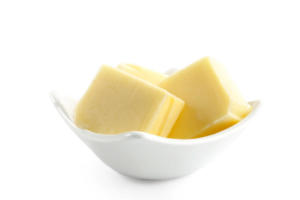 There has been some confusion as to which is healthier, margarine or butter. Margarine is usually the healthier choice but not always. Let’s look at how they differ.
There has been some confusion as to which is healthier, margarine or butter. Margarine is usually the healthier choice but not always. Let’s look at how they differ.
Most margarines contain little or no cholesterol. On the other hand, butter contains a significant amount of cholesterol. When making the choice between margarine or butter one needs to consider their specific dietary needs. What works for one may not necessarily work for the other.
Margarine is made from vegetable oils, so it contains unsaturated fats (polyunsaturated and monounsaturated) which are the good fats. These fats help reduce LDL or low-density lipoprotein, otherwise known as the “bad” cholesterol when substituted for saturated fat.
However, not all margarine is the same. The more solid the margarine the more trans-fat it contains, for example, stick margarine. Trans fat and saturated fat increases blood cholesterol levels and the risk of heart disease. It also lowers the “good” cholesterol or HDL.
Megan Ware-RDN LD of Medical News Today lists the three types of margarine and its nutritional breakdown:
A tablespoon of stick margarine contains:
- 80-100 calories
- 9-11 grams of fat
- 2 grams of saturated fat
- 1.5-2.5 grams of trans fat
- 0 grams of cholesterol
- 0 grams of carbohydrates
- 0 grams of sugar
This type of margarine may contain more calories than butter but often contains trans-fat as well.
Light margarine contains:
- 40 calories
- 5 grams of fat
- 1-1.5 grams of saturated fat
- 0 grams of trans fat
- 0 grams of cholesterol
- 0 grams of carbohydrates
- 0 grams of sugar per tablespoon
Light margarine has more water. As a result, it is lower in calories and fat. It also contains less saturated and trans-fat than regular margarine.
Margarine with phytosterols (plant-based compounds that are similar in structure to cholesterol) reduce cholesterol absorption and blood cholesterol.
Margarine with phytosterols contains:
- 70-80 calories
- 8 grams of fat
- 2.5 grams of saturated fat
- 0 grams of trans fat
- 0 grams of cholesterol per tablespoon
- 0 grams of carbohydrates
- 0 grams of sugar
When deciding on margarine, here are some things to keep in mind. The goal is to look for the least amount of trans fats (preferably 0 grams) and saturated fats. If it contains partially hydrogenated oils, it will contain trans-fat. Read the nutritional labels on the packaging and compare.
Here is the breakdown for butter. It isfirmer than margarine and contains more saturated fat because it is made from animal fat. Saturated fats raise the LDL or bad cholesterol and doesn’t affect the HDL or good cholesterol. If choosing butter, go with grass fed butter instead. It’s a healthier option.
One tablespoon of butter contains:
- 100 calories
- 12 grams of fat
- 7 grams of saturated fat
- 0.5 grams of trans fat
- 31 milligrams of cholesterol
- 0 grams of carbohydrates
- 0 grams of sugar
If you’re looking for a healthier alternative altogether, you can go with olive oil or other vegetable oil- based spreads which contain beneficial mono-and polyunsaturated fats. Remember, whatever you decide to go with use in moderation.

Jaena Mebane, a graduate of Fordham University-B.A., Fitness Professional, Bodybuilder and creator of GLUTEUS FABULOUS. My motto is “Inspiring Others to Live a Healthy Lifestyle, Mind, Body, and Soul.” You can find me on Instagram @gluteus_fabulous









